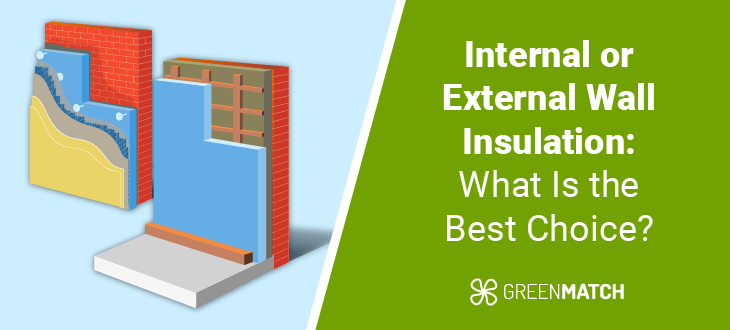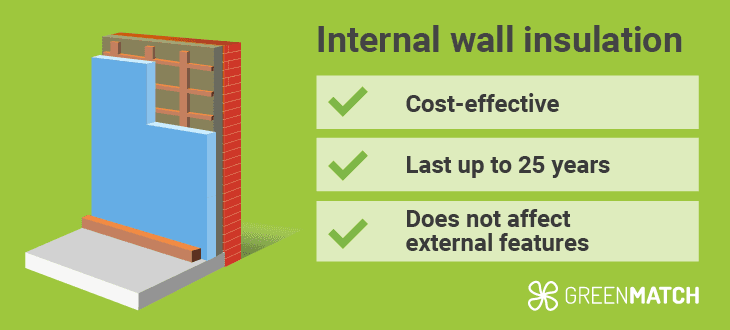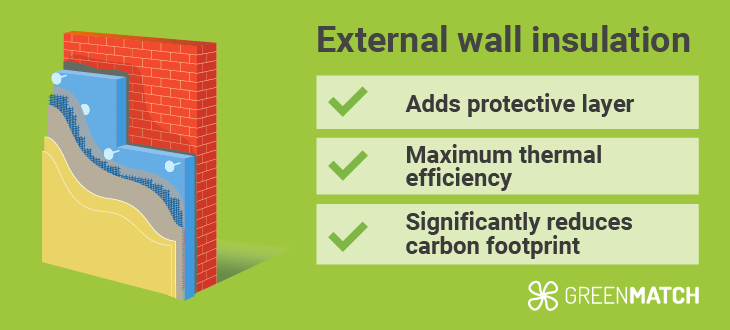Answer these simple questions and we will find you the BEST prices
Which type of solar quotes do you need?
It only takes 30 seconds
100% free with no obligation

Get Free quotes from insulation specialists near you

Save money by comparing quotes and choosing the most competitive offer

The service is 100% free and with no obligation
- GreenMatch
- Insulation
- Wall Insulation
- Internal VS External Insulation
Internal or External Wall Insulation: What Is the Best Choice?

- Internal wall insulation is more affordable than external insulation, often costing up to 50% less.
- External wall insulation provides superior thermal efficiency, resulting in greater long-term energy savings.
- Deciding between internal and external wall insulation depends on factors like budget, aesthetics, available space, and energy-saving goals.
Poorly insulated walls can account for up to 35% of the heat loss in your home, making them a major source of wasted energy. By properly insulating your walls, you could save up to £700 a year on energy bills and cut down your carbon emissions by as much as 2,100 kg of CO2 annually.
However, the key decision lies in choosing between internal and external wall insulation. Each option has unique benefits and challenges; your home's design, budget, and preferences determine which suits you best.
While internal wall insulation works well for older homes where altering the exterior isn’t feasible, external insulation improves your home’s energy efficiency without impacting interior space and can give your property a fresh new look.
Understanding which option is right for you might seem overwhelming, but don't worry—we’ve got you covered. In this guide, we'll explore everything you need to know, from the benefits and drawbacks to cost, efficiency, and aesthetics, to help you make the best choice for your home.
When deciding between internal and external wall insulation, consulting with a top-rated insulation specialist is the way to go. However, comparing multiple quotes can be time-consuming and might not always ensure the best fit for your needs and budget. That's where GreenMatch comes in. Fill out our quick 30-second form, and we'll provide up to four free quotes from the best insulation installers in your area tailored to your specific requirements. Save time and money - click below to get started!
- Describe your needs
- Get free quotes
- Choose the best offer
It only takes 30 seconds



Internal vs external wall insulation
Before choosing the best type of wall insulation for your home, it’s crucial to understand the difference between internal and external wall insulation. Both methods are designed for solid walls, which are present in about 30% of UK homes. Surprisingly, 97% of these solid walls remain uninsulated.
Solid brick wall insulation, commonly found in older homes made from a single layer of bricks, can benefit from either internal or external insulation. Unlike modern cavity walls, which have two layers with a gap for insulation, single brick walls are solid and offer very little natural thermal resistance, leading to significant heat loss. Proper insulation for these solid walls is essential to reduce energy waste and enhance comfort in your home. Below we go into what internal and external wall insulation is.
Internal wall insulation

Internal wall insulation involves adding insulating material to the interior side of your home's walls. You usually attach insulation boards or build stud walls filled with insulation. It's a popular choice for older properties where changing the exterior isn't an option or desirable.
Your budget is key when deciding between internal or external wall insulation. Internal wall insulation costs around £7,500 for a three-bedroom semi-detached house, which is considerably cheaper than external insulation—sometimes up to 50% less. Many homeowners opt for internal insulation to save on costs.
An advantage of internal insulation is that you don't need to insulate all the walls. Interior walls between rooms usually only require insulation if there are specific needs like soundproofing or temperature control.
This further reduces costs. When properly installed, internal wall insulation can last up to 25 years, offering long-term energy savings. For older homes with solid walls, breathable insulation materials can help release moisture, reducing the risk of dampness problems.
However, there are some drawbacks to consider. Internal wall insulation can be disruptive during installation, as rooms may become unusable until the work is done. It can also reduce your living space by up to 100mm. Improper installation can trap moisture inside walls, causing condensation and damp issues, especially without vapor barriers or proper ventilation.
Additionally, fixtures like electrical outlets, radiators, and skirting boards need to be removed and reinstalled, which increases time and costs. While internal insulation provides solid thermal efficiency, it's generally less effective than external insulation in preventing heat loss.
- Cost-effective
- Long lasting
- Can reduce risk of moisture
- Does not change external features
- Disruptive during installation
- Reduction in internal living space
- Fixtures need to be removed
- Less thermally efficient than external wall insulation
External wall insulation

External insulation is applied to the outside of your home by fixing insulating material to the exterior walls and covering it with a protective finish, such as render or cladding. This method improves the building’s thermal efficiency and is commonly used for homes with solid walls.
When comparing internal or external wall insulation, external insulation offers superior thermal performance, resulting in greater energy savings and a larger reduction in carbon emissions. Unlike internal insulation, it also preserves interior space, which reduces room size.
External wall insulation adds a protective layer to your home. It shields your home the weather and helps prevent dampness and water infiltration. It also helps reduce noise, making it ideal for homes in busy areas. Additionally, the insulation can give your home a fresh new look, saving on future maintenance or decorating costs.
However, this method can be expensive, with external wall insulation costs averaging around £12,000, depending on the size of the property and materials used. Installation can be disruptive, requiring scaffolding and potentially taking several weeks to complete. Access to certain parts of your home may be limited during this time.
Another potential disadvantage of external wall insulation is aesthetics. External insulation can enhance appearance but may not match traditional styles, potentially impacting the character of historic properties. You may also need planning permission, especially in conservation areas. Additionally, if walls are porous and the insulation is impermeable, moisture can get trapped, leading to damp problems. When choosing between internal or external wall insulation, external insulation provides the best energy savings and protection but involves higher upfront costs and potential installation challenges.
- Provides the best thermal efficiency
- Adds protective layer to your home
- Has biggest reduction in carbon footprint
- Provides home with a fresh look
- High-cost
- May require scaffolding
- Not suitable to traditional or historic homes
- May require planning permission
How to decide between internal and external wall insulation

Choosing between internal or external wall insulation can be challenging, as both have unique benefits and drawbacks. The right choice for your home depends on budget, space, aesthetics, and energy efficiency needs.
When is external wall insulation a better choice
External wall insulation is typically the better choice if you are focused on maximising energy efficiency and protecting the exterior of your home. Here’s when external insulation might be right for you:
- Maximising energy savings: External insulation wraps the entire building, reducing heat loss and addressing thermal bridges (gaps where heat escapes). This leads to better overall energy efficiency compared to internal insulation.
- Preserving interior space: If maintaining the size of your rooms is important, external insulation is ideal, as it does not affect the interior living space.
- Long-term savings: While external insulation has a higher upfront cost (around £12,000 on average), it offers significant long-term savings on energy bills. This investment can pay off for homeowners planning to stay on their property for years.
- Improving exterior appearance: External insulation can also give your home a new look, especially if the exterior needs updating or repairs.
- Noise reduction: External insulation helps reduce noise from outside, making it a great option for homes in busy urban areas or near main roads.
- Long-term protection: It provides a protective layer to your home’s exterior, shielding it from weather damage, dampness, and water infiltration.
When is internal wall insulation a better choice
Internal wall insulation is often more suitable if you’re on a tighter budget or want to maintain the original look of your home’s exterior. Here’s when internal insulation might be the better option:
- Lower cost: Internal insulation is usually more affordable than external, making it a budget-friendly choice, especially for retrofitting individual rooms.
- Preserving exterior: Internal insulation preserves your home's historic or decorative exterior, keeping the outward appearance intact.
- No need for planning permission: Internal insulation rarely requires planning permission, unlike external insulation, which may need approval, especially in conservation areas.
- Selective insulation: Internal insulation allows you to insulate specific rooms or walls, offering flexibility without insulating the entire home.
Key deciding factors
- Budget: External wall insulation is more expensive, averaging around £12,000, but offers greater long-term energy savings. Internal wall insulation is more affordable, with costs around £7,500, making it a more budget-friendly option upfront.
- Space impact: Internal wall insulation reduces indoor space slightly (up to 100mm), which may be an issue in smaller homes. External insulation doesn't impact interior space, preserving room size.
- Energy efficiency: External insulation provides better energy efficiency as it covers the home's exterior, reducing heat loss and addressing thermal bridges. Internal insulation is still effective but typically offers less comprehensive thermal protection.
- Aesthetic preferences: External insulation alters your home's appearance, which may modernise it, while internal insulation preserves the original exterior design.
- Disruption during installation: External insulation installation causes less disruption inside the home but may require scaffolding and exterior work for weeks. Internal insulation requires clearing rooms, removing fixtures, and redecorating afterward, making it a more intrusive option.
- Planning permission: External wall insulation may require planning permission, especially for homes in conservation areas or listed buildings. Internal insulation usually requires no permissions unless significant structural changes are made.
- Grants: Grants for wall insulation are available for internal and external insulation. If budget is a concern and you are eligible for a wall insulation grant, it may help you decide which one you prefer.
When choosing between internal or external wall insulation, it's crucial to weigh your budget, available space, and aesthetic preferences. Remember to explore potential grants that can assist you in making the right decision. Seeking advice from professionals is essential. GreenMatch is here to help by linking you with up to four free quotes from top-rated insulation specialists in your area, all tailored to your needs. Fill out our quick 30-second form to receive expert quotes, saving you valuable time and effort.
- Describe your needs
- Get free quotes
- Choose the best offer
It only takes 30 seconds



FAQ
The best choice between external and internal wall insulation depends on your priorities, such as budget, space, and whether you want to preserve or modify your home’s exterior. External insulation offers maximum thermal efficiency, while internal insulation is more cost-effective.
Whether it’s better to insulate walls internally or externally depends on your goals; external insulation offers superior thermal efficiency, while internal insulation is more affordable and preserves the exterior appearance.
The disadvantages of internal wall insulation include reduced interior space, potential installation disruption, and lower thermal efficiency compared to external insulation, along with the risk of moisture issues if not properly installed.
We strive to connect our customers with the right product and supplier. Would you like to be part of GreenMatch?

